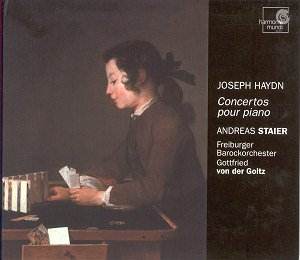First
let me comment on the recording which, as well as clarity, has
great depth of bass implying that the auditorium was appropriately
small. It turns out to have been the Teldex Studio in Berlin; a glance at their website shows it to be a small assembly-hall
sized wood-lined auditorium of which the company should clearly
be proud. The balance between piano and orchestra is very subtly
handled by the engineers (as well as the musicians), for example
in the Adagio of the G major H18/4 the piano is just
heard against the opening tutti and again we have that
amazingly deep bass. The recording is in fact clear enough to
hear, in a positive sense, Staierís pedalling effects throughout.
The
notes go a long way to lower expectations of musical quality,
talking of the minor role of the piano concerto in Haydnís output.
As a listener I did not find this to be the case. For example
the Rondo finale of the G major is enormous fun to hear
and seems to have provoked orchestra and pianist into the liveliest
music-making. In Hob.18/6 for piano and violin the finale is
an absolute ball and full of Haydnís wit with a lovely interplay
of instruments. I should not omit to mention the brilliant violin
solo of Gottfried von der Goltz. Hob.18/11 for piano and full
orchestra is the famous concerto, if any of them can be so described.
It is a whole new ball game. Music on an almost Beethovenian
scale. The first movement Vivace strays off into quite
remote tonal territory, a tiny suggestion perhaps of what Beethoven
put into his first piano concerto (the Piano concerto No.2 in
B flat major Opus 19). The second movement Un poco adagio
is so very delicate and again presages Beethoven, but oddly
not Mozart. The justifiably well known Rondo allíUngarese
is played with superb virtuosity by the Freiburg Baroque Orchestra
with string playing of extraordinary unanimity, with again that
wonderful bass. Andreas Staier makes much of the gypsy element
and conjures a huge range of colours out of his Walter copy
pianoforte.
There
is a cover picture of someone building a house of cards. The
significance escapes me, but itís a nice picture.
A
terrific CD.
Dave
Billinge

![]() Andreas Staier (pianoforte)
Andreas Staier (pianoforte)![]() HARMONIA
MUNDI HMC901854 [64:20]
HARMONIA
MUNDI HMC901854 [64:20]





